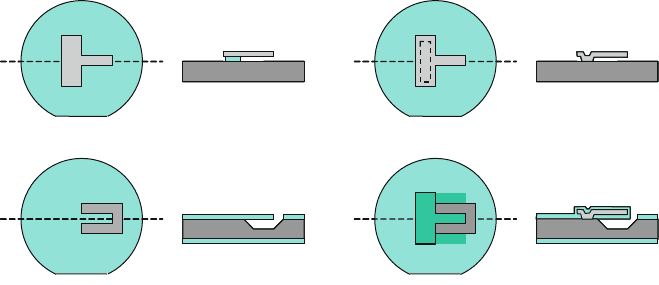Ghodssi R., Lin P., MEMS Materials and Processes Handbook
Подождите немного. Документ загружается.


604 D.W. Burns
Etch
Bath
Etchant
Patterned
Wafers
Thin-Film
Etch Stop
Fig. 8.15 Thin-film etch
stops for a nisotropic silicon
etching use one or more
etch-resistant layers on both
sides of the wafer, with one
side patterned. As the etch is
completed, the etch-stop layer
becomes free standing
squares on the bottom sides to expose 1–10 cm n-type (100) silicon surfaces.
A KOH-based etchant was selected for its high etching speed over a TMAH etchant.
After a 10-s predip into DHF etchant (10:1), the wafers are inserted with a Teflon
holder into a 30% KOH etchant at 90
◦
C in a double-wall quartz etch bath to remove
500 µm of silicon at a rate of 135 µm/h, taking about 3
3
/
4
h. A reflux condenser is
used on the etch flask to contain and condense evaporated water and etchant vapors.
The etch stops automatically on the buried oxide, although the wafers are inspected
visually at the estimated etch time to show nearly complete clearing and then rein-
serted for another 10 min of overetch. The wafers are rinsed in DI water for 10 min
in a cascade-style rinse with a polypropylene tube to inject water carefully under
the wafers, then blown dry with nitrogen. The remaining nitride is stripped off in
hot phosphoric acid. The masking oxide and exposed portions of the buried oxide
are subsequently removed in concentrated HF etchant (49%) for 2 min to expose
tethered portions of a galvanically actuated micromirror. The wafers are carefully
rinsed and dried, then diced between two sheets of dicing tape.
8.6.8.2 Example 2: Heavy Boron-Doped Etch Stop
A2µm-thick p-type epitaxial layer with a high boron concentration of 1.0 × 10
20
cm
–3
is grown epitaxially on a 1–10 cm p-type (100) silicon wafer. A 1.5 µm-
thick layer of low-temperature oxide is deposited on both sides of the wafer and
patterned on the bottomside. The 525 µm-thick wafer is inserted into EDP type F
etchant at 115
◦
Cfor6
1
/
2
h to remove exposed portions of the substrate and stop on
the p
++
epi layer. The oxide is stripped in a commercially available 6:1 buffered
oxide etch for about 12 min to free up a heater and sense elements for a mass air
flow sensor.
8.6.8.3 Example 3: Electrochemical Etch Stop
A CMOS wafer with a p-type substrate and active circuitry in 5 µm-deep n-wells has
aluminum bond pads. Portions of the substrate around designated n-wells on each
die have exposed silicon from a semicustom masking and etching step performed at
the end of standard CMOS processing. The wafer is inserted into a special fixture
that protects the sides and back of the wafer while allowing electrical connections

8 MEMS Wet-Etch Processes and Procedures 605
Table 8.30 Thin-film etch stops for anisotropic silicon etching
Material
Etch rate
selectivity Etchant Remarks and references
1 Aluminum
(Al)
1:12
3:2
Good
1:1
3300:1
KOH(30 wt%)
NH
4
OH(3.7 wt%)
NH
4
OH(doped)
TMAH(22 wt%)
TMAH(doped)
80
◦
C; etches Si(100) ∼180 Å/s [28]
75
◦
C; etches Si(100) ∼65 Å/s [460]
75
◦
C; 0.1 g/l Si added [460]
90
◦
C; etches Si(100) ∼165 Å/s [465]
90
◦
C; 75 g/l Si added [465]
2 Chrome (Cr) 260:1
Good
KOH(30 wt%)
NH
4
OH(3.7 wt%)
80
◦
C; etches Si(100) ∼180 Å/s [28]
75
◦
C; etches Si(100) ∼65 Å/s [460]
3 Copper (Cu) OK KOH(30 wt%) 80
◦
C; etches Si(100) ∼180 Å/s; thickens [28]
4 Gold (Au) Good
Good
Good
EDP(EPW)
KOH(30 wt%)
NH
4
OH(3.7 wt%)
110
◦
C; etches Si(100) ∼140 Å/s [442]
80
◦
C; etches Si(100) ∼180 Å/s; Au/Cr [28]
75
◦
C; etches Si(100) ∼65 Å/s [460]
5 Molybdenum
(Mo)
Good KOH(30 wt%) 80
◦
C; etches Si(100) ∼180 Å/s [28]
6 Nickel (Ni) Good KOH(30 wt%) 80
◦
C; etches Si(100) ∼180 Å/s [28]
7 Niobium
(Nb)
340:1 KOH(30 wt%) 80
◦
C; etches Si(100) ∼180 Å/s [28]
8 Palladium
(Pd)
Good KOH(30 wt%) 80
◦
C; etches Si(100) ∼180 Å/s [28]
9 Parylene
(Parylene
C)
2600:1 KOH(30 wt%) 80
◦
C; etches Si(100) ∼180 Å/s [28]
10 Photoresist
(PR)
1:16 KOH(30 wt%) 80
◦
C; etches Si(100) ∼180 Å/s [28]
11 Platinum (Pt) Good KOH(30 wt%) 80
◦
C; etches Si(100) ∼180 Å/s [28]
12 Polyimide
(PI)
OK KOH(30 wt%) 80
◦
C; etches Si(100) ∼180 Å/s; thickens [28]
13 Silicides Generally resistant to aqueous alkali etchants; see Table 8.20 [127]

606 D.W. Burns
Table 8.30 (continued)
Material
Etch rate
selectivity Etchant Remarks and references
14 Silicon, poly
(Si-poly),
boron
doped at 4
× 10
20
cm
–3
)
100:1 TMAH(22 wt%) 90
◦
C; etches Si(100) ∼165 Å/s [465]
15 Silicon–
germanium
(SiGe),
(100)
650:1
1200:1
240:1
155:1
EDP(EPW)
KOH(11/3 wt%)
TMAH(2 wt%)
TMAH(25 wt%)
95
◦
C; etches Si(100) ∼180 Å/s [476]
85
◦
C; etches Si(100) ∼165 Å/s [476]
85
◦
C; etches Si(100) ∼180 Å/s [476]
85
◦
C; etches Si(100) ∼70 Å/s [476]
16 Silicon
dioxide
(SiO
2
),
thermal
2500:1
140:1
9600:1
5000:1
EDP(EPW)
KOH(30 wt%)
NH
4
OH(3.7 wt%)
TMAH(22 wt%)
110
◦
C; etches Si(100) ∼140 Å/s [442]
80
◦
C; etches Si(100) ∼180 Å/s [28]
75
◦
C; etches Si(100) ∼65 Å/s [461]
90
◦
C; etches Si(100) ∼165 Å/s [465]
17 Silicon
dioxide
(SiO
2
),
LTO
OK
115:1
8300:1
EDP(EPW)
KOH(30 wt%)
NH
4
OH(3.7 wt%)
110
◦
C; etches Si(100) ∼140 Å/s [442]
80
◦
C; etches Si(100) ∼180 Å/s [28]
75
◦
C; etches Si(100) ∼65 Å/s [461]
18 Silicon
nitride
(Si
3
N
4
)
Good
Good
21000:1
Good
EDP(EPW)
KOH(30 wt%)
NH
4
OH(3.7 wt%)
TMAH(22 wt%)
110
◦
C; etches Si(100) ∼140 Å/s [442]
80
◦
C; etches Si(100) ∼180 Å/s [28]
75
◦
C; etches Si(100) ∼65 Å/s [461]
90
◦
C; etches Si(100) ∼165 Å/s [465]
19 Silver (Ag) OK KOH(30 wt%) 80
◦
C; etches Si(100) ∼180 Å/s; thickens [28]
20 Tantalum (Ta) Good
390:1
Good
EDP(EPW)
KOH(30 wt%)
NH
4
OH(3.7 wt%)
110
◦
C; etches Si(100) ∼140 Å/s [442]
80
◦
C; etches Si(100) ∼180 Å/s [28]
75
◦
C; etches Si(100) ∼65 Å/s [461]
21 Titanium (Ti) OK
Good
KOH
NH
4
OH(3.7 wt%)
80
◦
C; etches Si(100) ∼180 Å/s; softens [28]
75
◦
C; etches Si(100) ∼65 Å/s [461]

8 MEMS Wet-Etch Processes and Procedures 607
Table 8.30 (continued)
Material
Etch rate
selectivity Etchant Remarks and references
22 Titanium-
tungsten
(TiW)
7:2 KOH(30 wt%) 80
◦
C; etches Si(100) ∼180 Å/s [28]
23 Tungsten (W) Good KOH(30 wt%) 80
◦
C; etches Si(100) ∼180 Å/s [28]
24 Vanadium
(V)
90:1 KOH(30 wt%) 80
◦
C; etches Si(100) ∼180 Å/s [28]
608 D.W. Burns
to bond pads that are internally connected to the substrate and to the designated n-
wells from the exposed front side. A 1-L solution of 5% TMAH etchant in water
is freshly mixed with 38 g of silicic acid to reduce aluminum attack and 7 g of
ammonium persulfate (AP) to decrease surface roughness, then heated to 80
◦
Cina
quartz etch bath with a quartz reflux condenser.
Using Teflon-coated wire and a four-terminal electrochemical etch configuration,
the p-substrate is biased near the open-circuit potential at –1.5 V with respect to an
Ag/AgCl reference electrode in the solution and the designated n-wells are reverse
biased at +0.7 V with respect to the p-substrate. The fixture is immersed into the
etching solution, and etched for 1
3
/
4
h (160 Å/s) to produce a self-limiting 100 µm-
deep v-grooved cavity with (111)-oriented flanks while undercutting the 100 µm
by 50 µm designated n-wells. The oxide etches a total of 120 Å (0.019 Å/s) and
the aluminum etches a total of 80 Å (0.0125 Å/s). The wafer is carefully rinsed and
dried, and then diced with dicing tape on both sides of the wafer. Prior to wirebond-
ing, the dicing tape above each die is carefully peeled back to avoid breaking the
thermally isolated structures [511, 512].
8.7 Sacrificial Layer Etching
Sacrificial layers, structural layers, and a highly selective wet etch combine to form
freestanding microstructures for a wide variety of devices including cantilevered
beams, resonators, pressure sensors, accelerometers, gyroscopes, flow sensors, IR
detectors, inkjet heads, microphones, optical switches, microdisplays, microfluidic
devices, microtips, electrical probes, bio-MEMS and RF-MEMS devices, micro fuel
cells, and energy harvesting devices. Sacrificial layer etching is the selective removal
of thin films or portions of the substrate under structural layers that allows the struc-
tural layers to become freestanding, attached to the substrate at only predefined
locations. Cantilevered beams, for example, can be selectively undercut to make the
beam freestanding at all but the base. Doubly supported beams are attached at each
of two ends and freestanding elsewhere, and freestanding membranes, plates and
shells are attached to the substrate at one or more sides. Figure 8.16 shows a can-
tilevered geometry where the freestanding structure is undercut with a timed etch
and another where the sacrificial etching is self-stopping. The self-stopping process
architecture allows structures with different undercut lengths to be fabricated on
the same wafer at the s ame time, and provides the process engineer with a robust
etching procedure.
Lateral etching with a liquid or gaseous etchant allows the sacrificial layer to
be removed while leaving the structural layer intact. Extensive lateral etching is
generally difficult to achieve with a dry plasma or RIE etch, whereas selective liq-
uid etchants with their relatively small mean free path can enter very narrow and
tortuous paths to efficiently remove sacrificial layers.
Structural layers are generally several micrometers thick and sacrificial layers can
be several hundred angstroms to a hundred microns or more thick. The etchant must

8 MEMS Wet-Etch Processes and Procedures 609
a) b)
c) d)
Fig. 8.16 Surface-micromachined structures can be made freestanding by removal of an under-
lying sacrificial layer or portion of the substrate with extensive lateral etching by a selective wet
etchant. (a) A cantilevered beam, attached to the substrate through a support at the base, is freed
up with a timed etch and a single masking step. (b) A cantilevered beam, attached to the substrate
at the base through a patterned opening in the sacrificial layer, is freed up with a self-stopping etch
using two masking steps. (c) A cantilevered beam, formed from the passivation layer, is freed up
with a timed or a self-limiting anisotropic substrate etch using only one masking step. (d) A can-
tilevered beam, attached to the substrate at the base through a patterned opening in a passivation
layer, is freed up with a selective substrate etch using a total of three masking steps
be very selective to effectively remove the sacrificial layer and leave the structural
layers intact without much if any thinning. A high etch selectivity implies that the
sacrificial layers are etched much faster than the structural layers and other layers
that support the structural layers.
The etch rate and etch selectivity combine with the thickness of the structural
layer to determine the maximum amount of time that the die or wafers can be in the
etchant. An etchant with high selectivity allows the devices to be in the etchant for
an extended time and provides significant overetching capability. In cases where the
etch time is unduly limited, the user generally can make adjustments to the process
or to the device design. The process may be adjusted by choosing a more selective
etch process, using more selective materials, or incorporating an etch accelerator
layer. Design alterations may limit the amount of time required in the etchant, for
example, by limiting the undercut distance with narrower structural features or by
strategically placing small openings in the structural features so that the etchant has
local access to the sacrificial layer.
Certain devices require an isolation layer between the sacrificial layer and sub-
strate, such as an LPCVD silicon nitride layer for electrical isolation. The etchant
must similarly be selective over any isolation or passivation layers.
As surface-micromachined devices can be quite fragile after sacrificial etching,
the etching and drying steps are generally placed late in the process sequence, and
careful handling procedures may be needed to avoid unnecessary contact with or
undue forces on the microstructures during subsequent dicing and packaging steps.
610 D.W. Burns
For particularly fragile structures, special rinse liquid removal techniques may need
to be adopted. Devices subject to release stiction or in-use stiction may incor-
porate a coating such as a self-assembled monolayer (SAM) into the final rinse
procedure.
8.7.1 Sacrificial Layer Removal Techniques
Wet chemical etching remains predominant in removal of sacrificial layers for
MEMS devices. A room-temperature etchant using standard cleanroom chemicals
and an etch process with abundant overetch capability followed by standard DI
water rinse procedures may be satisfactory for relatively stiff structures. For exam-
ple, a buffered HF etch followed by a set of dump rinses and a spin–dry sequence
may be used to free long, narrow polysilicon shells with no special handling
considerations.
For fragile structures, wet chemical etching may be augmented with special pro-
cedures to prevent breakage of the microstructure and reduce yield losses due to
stiction from surface tension, van der Waals forces, and solid-residue bridging.
Techniques such as freeze-sublimation drying or critical-point drying can be applied
that prevent the microstructure from coming into surface-to-surface contact with the
substrate and avoid opportunities for unwanted adherence from stiction.
Low surface-tension coatings may improve the process yield and device reli-
ability. These may be applied as part of the final drying sequence, or be applied
postrelease yet prior to packaging.
Dry vapor etching techniques can successfully free microstructures. By avoiding
contact with any liquid, the capillary forces that tend to drive the microstructure into
contact with the substrate during drying are effectively nullified. Vapor HF is one
example of a dry release technique that can be done in specially designed fixtures
[513]. Controlled gaseous xenon difluoride etching can selectively remove exposed
portions of the silicon substrate and polysilicon layers to release metal and dielectric
structures using a vapor phase etch without any liquids or plasmas [514–518]. With
high selectivity to photoresist, silicon dioxide, silicon nitride, and aluminum, this
isotropic etch can be highly effective for integrated MEMS devices to avoid issues
related to stiction and provide compatibility with active on-chip devices. Under var-
ious conditions of pressure and temperature, other vapor etchants may be used to
etch silicon including Cl
2
,H
2
O, H
2
S, HBr, HCl, HI, HI-HF, and SF
6
[25]. Dry
plasma etching with SF
6
and other etchants has been shown to be effective i n selec-
tively etching portions of a silicon substrate or a polysilicon sacrificial layer with
moderate selectivity to oxide [519, 520].
Other sacrificial layer removal techniques include plasma or reactive ion etching
of photoresist or other sacrificial materials to free up structural layers selectively. For
example, an e-beam evaporated aluminum film on top of photoresist or polyimide
can be patterned and etched, then the organic layer removed in an oxygen plasma
[521, 522].
8 MEMS Wet-Etch Processes and Procedures 611
8.7.2 Sacrificial Oxide Removal for Polysilicon Microstructures
A predominant number of devices use deposited polysilicon thin films as the struc-
tural layer and silicon dioxide as the sacrificial layer, in part because the polysilicon
films are IC compatible and structurally well-matched with the substrate, in part
because the oxide layer is also IC compatible, and in part because hydrofluoric-
based etchants have an extremely high selectivity to oxide over polysilicon. Lateral
etches may exceed 500 µm, and the HF-based etchants can clear sacrificial oxides
fewer than 100 Å thick with little impediment [523]. Polysilicon films for struc-
tural layers may be deposited as fine-grained, stress-controlled films. They may
be codeposited with germanium as SiGe films, or doped in situ. Epitaxial pro-
cesses for epi-poly, sputtered poly, and even amorphous silicon may also serve as
structural layers. The underlying sacrificial oxide may be thermally grown offer-
ing the highest quality yet the slowest etching oxide. Low-temperature CVD oxides
(LTO), doped oxides (BSG, PSG, and BPSG), sputtered oxides and spin-on glass
(SOG) can be effectively used as sacrificial layers and etch much faster to pro-
vide shorter sacrificial etch times. A fast-etching oxide over a slow-etching thermal
oxide serves as an etch accelerator layer to decrease the total etch time. A bil-
aminate layer such as oxide over silicon nitride allows the oxide to be removed
with only minor etching of the nitride that may continue to serve as a buffer or
isolation layer. Table 8.31 shows a progression of removal techniques for oxide
sacrificial layers and polysilicon microstructures with various oxide types and
etchants.
8.7.3 Alternative Sacrificial and Structural Layer Combinations
Deposited polysilicon, either LPCVD, PECVD, sputtered, or epi-poly, can serve
alternatively as a sacrificial layer for oxide or nitride freestanding structures. Metals
such as aluminum that are readily etched also may be used as sacrificial layers.
Polymers including photoresist with overlying deposited layers of e-beam or sput-
tered metals have been used as sacrificial layers. Various alternative sacrificial layers
and structural layers for MEMS devices have been proposed or explored, including
structural layers of chromium, copper, gold, molybdenum, nickel–chrome, niobium,
palladium, platinum, polyimide, silicon nitride, silver, tantalum, titanium–tungsten,
tungsten, and vanadium, with sacrificial layers s uch as deposited unannealed PSG
with an HF etchant [28].
Several authors have compiled collections of actual and prospective structural
and sacrificial layers based largely on silicon substrates and silicon semiconductor
manufacturing [28, 78, 408]. Nonsilicon systems such as III-V compounds also have
seen development of a number of successful sacrificial layers, structural layers, and
highly selective etchants and have been itemized elsewhere [532]. Table 8.32 lists a
number of sacrificial and structural layer combinations with particular emphasis on
etchants commonly available in development and manufacturing sites.

612 D.W. Burns
Table 8.31 Sacrificial layer removal for polysilicon microstructures
Structural
layer/sacrificial
layer
Etch rate
(Å/s) Etchant Remarks and references
1 Polysilicon (Si,
poly)/oxide
(SiO
2
, CVD)
BHF Room temperature; BHF etchant; 640
◦
C
polysilicon deposition; 1100
◦
C anneal;
0.23–2.3 µm thick; 0.55–3.5 µmgap;
25–200 µm long cantilevers;
15–60 µm wide; 100–500 µm bridges;
CVD oxide sacrificial layers; implanted
PSG oxide etch accelerator layer;
compressive films [524]
2 Polysilicon (Si,
poly)/oxide
(SiO
2
,
thermal)
HF(49%)
undiluted
Room temperature; HF etchant (49 wt%);
635
◦
C polysilicon deposition;
high-temperature anneal; 2.0 µmthick;
1.0 µm gap; 200 µm × 200 µm plates;
thermal oxide sacrificial layer; reactive
sealing (vacuum sealing) with oxide or
poly; 0.01% compressive strain after
annealing [525]
3 Polysilicon (Si,
poly)/oxide
(SiO
2
, PSG)
5400 HF(49%)
undiluted
Room temperature; HF etchant (49 wt%);
950
◦
C anneal of PSG sacrificial layer;
lateral etch rate for PSG(8 wt%); etch
rate slows after ∼280 µm of undercut;
etch rate lessens for HF dilution and
lower phosphorus content [526, 527]
4 Polysilicon (Si,
poly)/oxide
(SiO
2
,
thermal)
250 HF(73%)
undiluted
Room temperature; HF etchant (49 wt%);
etches slightly Al (0.35 Å/s) with 680:1
selectivity (40:1 selectivity with pad
etch); add glycerol to BHF for 170:1
selectivity over Al; etches SiO
2
(300 Å/s) in HF(73%):IPA 2:1; avoid
water rinsing [93]
5 Polysilicon (Si,
poly)/oxide
(SiO
2
, SOG)
BHF Room temperature; BHF etchant; 425
◦
C
cure of spin-on glass [528]
6 Polysilicon (Si,
poly)/oxide
(SiO
2
,
thermal)
45 HF(49%):
H
2
O
1:1, vapor
20
◦
C; vapor HF etchant; sample at 31.5
◦
C
(critical) positioned in vapor above HF
bath; avoid condensation; avoid
substrate overheating [529, 530]
7 Polysilicon (Si,
poly)/oxide
(SiO
2
, PSG)
48 HF(49%)
undiluted,
vapor
35
◦
C; vapor HF etchant; bubbled N
2
through HF; slight vacuum; etches
Al(0.5%Cu) (0.005 Å/s), SiO
2
-thermal
(2.5 Å/s), Ti (0.03 Å/s), TiN (0.01 Å/s)
[531]

8 MEMS Wet-Etch Processes and Procedures 613
Table 8.32 Sacrificial layer removal for alternative structural and sacrificial layer combinations
Structural
layer/sacrificial layer
Etch rate
(Å/s) Etchant Remarks and references
1 Aluminum (Al)/silicon
(Si)
165–500 XeF
2
(vapor)
4Torr
Room temperature; XeF
2
vapor etchant; aluminum traces and oxide
encapsulated polysilicon; doesn’t significantly etch Al, PR, Si3N
4
,
SiO
2
; loading and surface preparation effects [514]
2 Aluminum (Al)/oxide
(SiO
2
, SOG)
70 Ammonium fluoride,
acetic acid
Room temperature; pad etchant; etches Al (0.5 Å/s); DI water rinse
[90, 533]
3 Aluminum gallium
arsenide
(AlGaAs)/gallium
arsenide (GaAs)
650 NH
4
OH(29%):
H
2
O
2
(30%)
1:30
25
◦
C; Al
x
Ga
1−x
As structural layer with x > 0.4; 650:1 selectivity at
x = 0.6 [196]
4 Aluminum nitride
(AlN)/oxide (SiO
2
,
PSG)
165 NH
4
F(40%):Acetic:
H
2
O
2:2:1
Room temperature; structural layer includes Al and Pt/Ta electrodes;
DI water rinse [534]
5 Gallium arsenide
(GaAs)/AlGaAs
HF(49%):H
2
O
1:4
Room temperature; DHF etchant (4:1); GaAs substrate and structural
layer; Al
x
Ga
1−x
As sacrificial layer with x > 0.5 [532]
6 Germanium (Ge,
poly)/oxide (SiO
2
,
LTO)
BHF Room temperature; BHF etchant; also etches in HF etchant; 400
◦
C
LPCVD Ge deposition; poly-Ge can be etched in hot
NH
4
OH(29%):H
2
O
2
(30%):H
2
O 1:1:5 at 500 Å/s or piranha [535]
7 Gold (Au)/aluminum
(Al)
50
◦
C gold electroplating; aluminum or copper sacrificial layer [536]
8 Indium arsenide
(InAs)/aluminum
antimonide (AlSb)
HF(49%):H
2
O
1:20
Room temperature; DHF etchant (20:1); InAs structural layer;
aluminum antimonide sacrificial layer; doesn’t significantly etch
GaAs [130]
9 Indium gallium arsenide
phosphide
(InGaAsP)/indium
gallium arsenide
(InGaAs)
HF(49%):
H
2
O
2
(30%)H
2
O
1:1:8
Room temperature; structural layer is predominantly InP; sacrificial
layer is In
0.53
Ga
0.47
As; DI water rinse [537]
